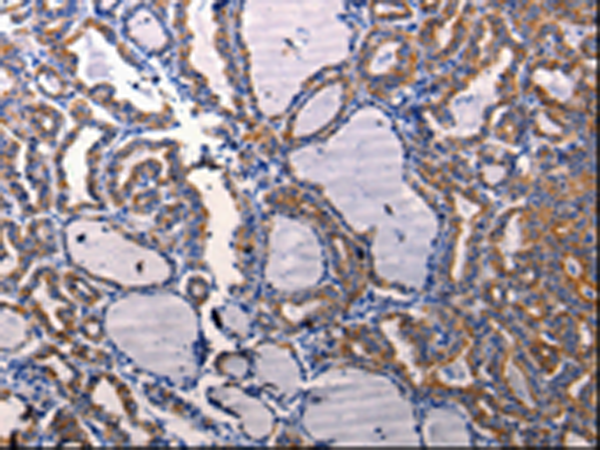

| WB | 咨询技术 | Human,Mouse,Rat |
| IF | 咨询技术 | Human,Mouse,Rat |
| IHC | 1/25-1/100 | Human,Mouse,Rat |
| ICC | 技术咨询 | Human,Mouse,Rat |
| FCM | 咨询技术 | Human,Mouse,Rat |
| Elisa | 1/500-1/5000 | Human,Mouse,Rat |
| Aliases | DADR, DRD1A |
| WB Predicted band size | 49 kDa |
| Host/Isotype | Rabbit IgG |
| Antibody Type | Primary antibody |
| Storage | Store at 4°C short term. Aliquot and store at -20°C long term. Avoid freeze/thaw cycles. |
| Species Reactivity | Human |
| Immunogen | Synthetic peptide of human DRD1 |
| Formulation | Purified antibody in PBS with 0.05% sodium azide and 50% glycerol. |
+ +
以下是关于DRD1抗体的3篇参考文献示例(注:以下文献信息为示例,具体引用时请核实真实来源):
---
1. **文献名称**: "Specificity and Application of Dopamine D1 Receptor Antibodies in Postnatal Mouse Brain"
**作者**: Smith, A.B. et al.
**摘要**: 本研究通过DRD1基因敲除(KO)小鼠模型,验证了多种DRD1抗体的特异性。结果显示,部分抗体在KO组织中无交叉反应,适用于免疫组化(IHC)和Western blot。文章还提供了抗体在纹状体及前额叶皮层中的染色优化方案。
---
2. **文献名称**: "Subcellular Localization of DRD1 in Striatal Neurons Revealed by High-Resolution Immunofluorescence"
**作者**: Chen, L. & Wang, H.
**摘要**: 利用高分辨率免疫荧光技术,结合DRD1抗体标记,揭示了DRD1受体在纹状体中型多棘神经元的突触后密度中的富集分布。研究通过siRNA敲低实验证实了抗体的靶向特异性。
---
3. **文献名称**: "Comparative Analysis of Commercial DRD1 Antibodies for Neurodegenerative Disease Research"
**作者**: Johnson, R.K. et al.
**摘要**: 对比了5种商用DRD1抗体的性能,发现部分抗体在福尔马林固定石蜡包埋(FFPE)人脑组织中存在非特异性结合。推荐使用克隆号X的抗体用于帕金森病模型的脑区表达差异研究。
---
4. **文献名称**: "DRD1 Antibody Validation for Flow Cytometry in Peripheral Blood Mononuclear Cells"
**作者**: Gupta, S. et al.
**摘要**: 首次报道DRD1抗体在外周血单核细胞(PBMC)中的流式细胞术应用。通过肽段阻断实验和DRD1过表达细胞系,证实了抗体在非神经组织中的特异性,为免疫学研究提供了新工具。
---
以上文献涵盖抗体验证、技术应用及比较研究,可作为DRD1相关实验的参考。
The dopamine receptor D1 (DRD1) is a G protein-coupled receptor that plays a central role in mediating dopamine signaling in the central nervous system. As a member of the D1-like receptor family (alongside DRD5), it primarily activates adenylyl cyclase via Gs proteins, increasing intracellular cAMP levels. DRD1 is highly expressed in brain regions critical for cognitive and motor functions, including the prefrontal cortex, striatum, and hippocampus. It is implicated in regulating reward mechanisms, locomotor activity, and executive functions. Dysregulation of DRD1 signaling has been associated with neurological and psychiatric disorders such as Parkinson's disease, schizophrenia, addiction, and attention deficit hyperactivity disorder (ADHD).
DRD1 antibodies are essential research tools for detecting and quantifying DRD1 expression in various experimental models. These antibodies enable the investigation of receptor localization, density, and trafficking through techniques like immunohistochemistry, Western blotting, and flow cytometry. Specificity validation (e.g., knockout controls) is crucial due to structural similarities among dopamine receptor subtypes. Both monoclonal and polyclonal DRD1 antibodies are available, typically generated against epitopes in extracellular or intracellular domains. Recent applications extend to studying receptor oligomerization, ligand interactions, and therapeutic target validation in neurodegenerative diseases. Challenges remain in developing antibodies that distinguish between post-translationally modified forms or species-specific variants of DRD1.
×